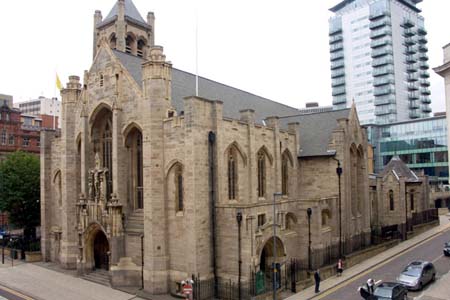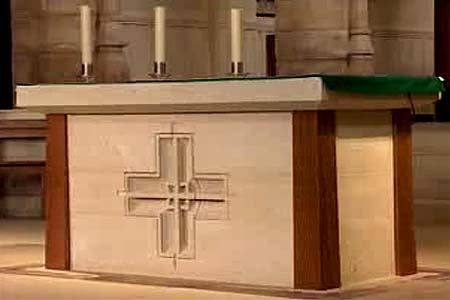| |
 |
 |
 |
| Comment on this report, or find other reports. |
 |
| Our Mystery Worshippers are volunteers who warm church pews for us around the world. If you'd like to become a Mystery Worshipper, start here. |
 |
| Find out how to reproduce this report in your church magazine or website. |
|
|
| 2808: Leeds Cathedral, England |
 |
 |
 |
Mystery Worshipper: Divine Praises.
The church: Cathedral Church of St Anne, Leeds, England.
Denomination: Roman Catholic, Diocese of Leeds.
The building: Begun in 1901, completed in 1904, and restored in 2006, St Anne's Cathedral was designed in the Arts and Crafts Gothic Revival style by Leeds-born architect John Henry Eastwood. Eastwood was one of the founding members of the Guild of St Gregory and St Luke, established to raise the standard of design and furnishings in Catholic churches. The west front features a tall gable flanked by buttresses topped by turrets. There is a small tower at the north end. The interior is rather conventional, with nave, chancel, side chapels, and unusually small transepts due to the narrow dimensions of the lot on which the cathedral stands. In the new versus populum altar are enshrined the relics of Peter Snow and Ralph Grimston, beheaded in 1598 (with their severed heads exposed on spikes) for being a Catholic priest and for being an aide to a Catholic priest, respectively. The original ad orientem high altar by Augustus Welby Pugin has been relocated to the Lady chapel.

The church: They support the Catholic Care charity as well as a family life ministry and the Leeds Justice and Peace Commission. There are three masses each Sunday plus the Saturday vigil mass. Mass, vespers, and exposition of the Blessed Sacrament take place each weekday.
The neighbourhood: The compact centre of Leeds is largely given over to retail and leisure, with a sizeable legal/financial district lying to the south of the cathedral. Just to the north is the civic centre, along with two universities and the huge site of the Leeds General Infirmary.
The cast: The Revd Msgr Philip Moger, dean of the cathedral, assisted by the Revd Mr Michael Mkpadi, deacon. (But I had to ask one of the ushers.)
The date & time: The Epiphany of the Lord, Sunday, 4 January 2015, 11.00am.
What was the name of the service?
Holy Mass.
How full was the building?
All the pews were full. There were also chairs set out at the end of the rows and these looked pretty well filled too. I had to turn around to estimate the number of people behind me, and I felt the ghostly hand of my mother smacking me on the head for committing that cardinal sin.
It appeared that most of the worshippers weren't resident close to the cathedral. An extraordinary mix of ages, ethnicity and nationalities was represented.
Did anyone welcome you personally?
I got a rather distracted smile from a harassed looking usher as he thrust a hymnal, bulletin and mass book into my hands. To be fair, he was being assailed by people coming at him from three sides from the doors and porches open at the west end of the cathedral. I noticed, entirely irrelevantly, that the usher was wearing a kind of morning dress with a blue waistcoat. I like eccentricity, and he was working more than hard enough to justify any sartorial eccentricity.
Was your pew comfortable?
Yes – it was a modern wooden pew deep enough to accommodate my long shanks. No padding, but padded kneelers.
How would you describe the pre-service
atmosphere?
Not quiet, but not because of people talking. The noise simply came from the numbers of people arriving for mass, along with the subdued hubbub that many small children engender. In any case, the organ prelude covered the sound quite amply.
What were the exact opening words of the
service?
In Latin: In nomine Patris, et Filii, et Spiritus Sancti.
What books did the congregation use during the
service?
Sunday bulletin with readings, Latin mass booklet and hymn book.
What musical instruments were played?
Organ, an opus of Norman and Beard dating from 1904. Silent since around 1980, it was restored in 2009 by Johannes Klais Orgelbau GmbH & Co. KG of Bonn, Germany. The restoration featured reinstallation of the original pipework in its original chests, as well as addition of new pipework carefully voiced to complement the original. There was a second collection taken up for the diocesan music programme, which includes maintenance of the new organ. The cathedral choirs were on holiday, so music was provided by a guest choir from St Austin's, Wakefield.
Did anything distract you?
Hmm, where to start? As people arrived, I tried to work out where they were from. Then I received a stern look from a religious sister walking up and down the centre aisle, which recalled me to my first purpose of being here this morning. So I plonked myself on the kneeler and tried to pray the Glorious Mysteries of the Rosary, ignoring the susurration of sound around me. That was Purgatory for me, given that I wanted to see what was going on, but I'm sure all that prayer did some poor soul in Purgatory some good. The good sister also popped in and out of the sacristy several times; perhaps she was making sure that Monsignor was reciting the vesting prayers with proper reverence.

Was the worship stiff-upper-lip, happy clappy, or
what?
As upper-lip as lips can be! Definitely formal – Latin from start to finish, apart from the Kyrie (Greek, naturally).
The mass setting was the Mass in A minor by the 18th century Italian composer Claudio Casciolini (sans Credo, which we sang antiphonally to Credo III). I feel the parishioners of St Austin's are very fortunate to have such a set of singers supporting their liturgy.
That being said, the whole mass felt very unpressured. I noticed, for example, a young woman, two pews ahead of me, guiding a young man through the Latin texts.
But I also noticed the antics of a little girl skipping out into the aisle just after the gifts went into procession. Nobody seemed to be paying any attention until the child arrived at the altar steps. Then a man came out from his pew and turned her around, and she skipped back toward her father, who was standing in the aisle looking for her. Distracting, yes, but I thought of Psalm 84: "Even the sparrow finds a home, and the swallow a nest for herself ...
at your altars, O Lord of hosts."
Exactly how long was the sermon?
7 minutes.
On a scale of 1-10, how good was the preacher?
8 – Some people might say Msgr Moger's style was boring. It was very deliberate, emphatic even, but I found it arresting and I suspect it was, at least in part, aimed at the multi-lingual mix of the cathedral congregation.
In a nutshell, what was the sermon
about?
Think about travel and travel hold-ups.
Many of us have been victims of travel delays over the Christmas period. But what about the Magi and the journey they undertook to find the Infant King of the Jews? There's no mention in the gospels of the problems they endured in getting to the Holy Land, but think about the difficulties of their journey and what they found when they arrived there.
The leaders of the people, both civil and religious, failed to help the Wise Men find the infant Messiah. They ignored the signs given through the Old Testament prophecies, and instead pursued their own ambitions, even though the prophecies were being fulfilled before them. Doesn't that sound awfully like today?
Which part of the service was like being in
heaven?
The whole mass was offered with great care and dignity, and I loved the mix of ages, nationalities and ethnicities. I was also warmed by the communion that people seemed to share with each other when, for example, we were all jumbled up at the Pax.
I also loved the fact that the mass was in Latin – not just my own prejudices coming through here, but I noticed that the bulletin was available in French and Spanish also.
And which part was like being in... er... the other place?
I'm scared of being written out of the Book of Life, but here goes.
There were lots of things going on that I don't really care for – for example, holy communion standing, and given in the hand. Also, it might seem trivial, but the altar cloth at the cathedral is one of those that fits the top of the altar only. I understand that this may be a fashion these days, but I couldn't help thinking back to my youth and the ample altar cloths that rivalled the lace-edged tablecloth my grandmother used to put out for Sunday dinner.
What happened when you hung around after the service looking lost?
'Twas chaos: a scrum of people heading for the holy water font, seeking to bless themselves and/or catch the clergy at the back of church.
How would you describe the after-service
coffee?
There was a heartfelt plea from Msgr Moger for us all to head to the cathedral hall for coffee and refreshments after mass. But I had a pressing appointment with friends and so I had to forego the opportunity.
How would you feel about making this church your regular (where 10 = ecstatic, 0 = terminal)?
9 – I am torn.
My regular place of worship has not really been touched by the diocese's music programme. And the cathedral isn't very far to drive to attend regular Sunday masses there. Do I stay put and try to remind my choirmaster at home that the contemporary church musician Paul Inwood (who is quoted as having once said, "Chant was never honoured by Church until the 19th century") isn't sacrosanct? Or do I dive into a pool of liturgical excellence?
Did the service make you feel glad to be a
Christian?
Oh yes, on so many levels.
I know I have a prejudice, but seeing so many hundreds of Christians making the Sign of the Cross at In nomine Patrii...
What one thing will you remember about all this in seven days' time?
Seeing the little girl wandering the aisle. |
|
|
 |
 |
 |
| We rely on voluntary donations to stay online. If you're a regular visitor to Ship of Fools, please consider supporting us. |
 |
 |
 |
| The Mystery Pilgrim |
 |
| One of our most seasoned reporters makes the Camino pilgrimage to Santiago de Compostela in Spain. Read here. |
 |
 |
 |
| London churches |
 |
| Read reports from 70 London churches, visited by a small army of Mystery Worshippers on one single Sunday. Read here. |
| |
|
|
|
|


